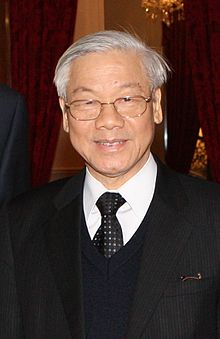越南共产党中央委员会总书记
| 越南共产党中央委员会总书记 | |
|---|---|
 越南共产党党旗 | |
 現任 阮富仲 2016年1月28日就任 | |
| 尊稱 | 同志 |
| 类别 | 政党领袖 |
| 官邸 | 1A Hùng Vương, Ba Đình, Hà Nội |
| 任命者 | 中央委员会 |
| 任期 | 五年 可连任一届 |
| 首任 | 陈富 |
| 设立 | 1930年10月27日 |
越南共产党中央委员会总书记 | |
| 國語字 | Tổng Bí thư Ban Chấp hành Trung ương Đảng Cộng sản Việt Nam |
|---|---|
| 喃字 | .mw-parser-output .han-nom{font-family:"Nom Na Tong","Han-Nom Gothic","HAN NOM A","HAN NOM B","Ming-Lt-HKSCS-UNI-H","Ming-Lt-HKSCS-ExtB","FZKaiT-Extended","FZKaiT-Extended(SIP)","FZKaiS-Extended","FZKaiS-Extended(SIP)","Sun-ExtA","Sun-ExtB","MingLiU","MingLiU-ExtB","MingLiU_HKSCS","MingLiU_HKSCS-ExtB","SimSun","SimSun-ExtB",sans-serif} 總秘書班執行中央黨共産越南 |
第一书记 | |
| 國語字 | Bí thư Thứ nhất |
|---|---|
| 喃字 | 秘書次一 |
越南社会主义共和国 |
|---|
 |
越南政府与政治 系列条目 |
越南共产党
|
憲法 |
立法機構
|
行政機構
|
祖國陣線
|
司法机构
|
外交 |
其他
|
|
越南共产党中央委员会总书记(越南語:Tổng Bí thư Ban Chấp hành Trung ương Đảng Cộng sản Việt Nam),1951年至1976年称第一书记(越南語:Bí thư Thứ nhất),是越南共产党的最高负责人。1951年至1969年胡志明担任中央委员会主席时这一职位为党内第二高。总书记同时还是党军事机关中央军事委员会书记[1],为越南人民军实际上的统帅。胡志明死后越共不再设党主席,因此总书记成为越南党和国家最高领导人的职务。现任总书记为阮富仲[2][注 1]
1930年與胡志明合作組織成立印度支那共产党、作為创始人之一的陈富當選为首任党总书记,但在一年后便因其反法活动被当局投入监狱,并于同年在狱中去世[5]。陈富的事实继任者为黎鸿峰——由于中央委员会基本上已不复存在,海外执行委员会总书记即成为了党总书记[6]。第三任总书记何辉集于1938年3月去职,并于5月被当局逮捕[7]。第四任总书记阮文渠于1940年6月被捕,于1941年5月2日被枪决。1941年5月长征接替其职位[8]。1951年3月25日《人民报》的一篇文章称长征为革命的“缔造者和指挥官”,称胡志明为“越南革命和越南抵抗运动的灵魂”[9]。1956年长征因其在土地改革中的政策决策而被降职[10]。黨的最高領導人胡志明親自出任第一书记,但很快便任命黎笋为代理第一书记[11]。1960年黎笋正式当选总书记,在胡志明于1969年9月2日去世前为党内二号人物[12]。
胡志明在1969年死后,党内不再设主席一职,黎笋在1969年9月2日至1986年7月10日(其去世)间成为无可争议的越南一号人物[13]。他在下一届党全国代表大会开始前两个月去世,长征接替其职位。第六届党代会后长征再次被降职,阮文灵接替其职位[14]。阮文灵推行改革,西方媒体由此称其为“越南的戈尔巴乔夫”[15]。1991年阮文灵因健康原因去职,第七届党代会选举杜梅为总书记[16]。1997年在党内改革派的压力之下杜梅去职[17],黎可漂作为折衷候选人当选总书记[18]。2001年第十届党代会前夕中央委员会否决了政治局的一项决策,并投票罢免了黎可漂[4]。农德孟接替其职位,推行现代化政策;他同时还是首位拥有大学学历的总书记[19]。2011年农德孟在越南共产党第十一次全国代表大会上退休,阮富仲接替其职位,但并未取代其越南领导人的地位[2]。2016年1月28日,越共十二届一中全会上,阮富仲再次当选越共中央委员会总书记。
目录
1 越共中央历任主要负责人
2 注释
3 参考文献
3.1 引用
3.2 来源
越共中央历任主要负责人
| № [注 2] | 姓名 (生卒) | 就任 | 去任 | 顺位 [注 3] | 中央委员会 | 肖像 |
|---|---|---|---|---|---|---|
| 1 | 陈富 Trần Phú (1904–1931) | 1930年10月27日 | 1931年9月6日 | 1 | 中央临时委员会(1930–35) |  |
| 2 | 黎鸿峰 Lê Hồng Phong (1902–1942) | 1931年10月27日 | 1936年7月26日 | 1 | 第一届中央委员会(1935–51) |  |
| 3 | 何辉集 Hà Huy Tập (1906–1941) | 1936年7月26日 | 1938年3月30日 | 1 |  | |
| 4 | 阮文渠 Nguyễn Văn Cừ (1912–1941) | 1938年3月30日 | 1940年11月9日 | 1 |  | |
| 5 | 长征 Trường Chinh (1907–1988) | 1941年5月 | 1956年9月24日 | 1 [注 4] | 第一届中央委员会(1935–51) |  |
| 2 | 第二届中央委员会(1951–60) | |||||
| 6 | 胡志明 Hồ Chí Minh (1890–1969) | 1956年9月24日 | 1960年9月10日 | 1 | 第二届中央委员会(1951–60) |  |
| 第三届中央委员会(1960–76) | ||||||
| 7 | 黎笋 Lê Duẩn (1907–1986) | 1960年9月10日 | 1986年7月10日 | 2 [注 5] |  | |
| 1 | 第四届中央委员会(1976–82) | |||||
| 第五届中央委员会(1982–86) | ||||||
5 | 长征 Trường Chinh (1907–1988) | 1986年7月14日 | 1986年12月18日 | 1 | 第五届中央委员会(1982–86) |  |
| 8 | 阮文灵 Nguyễn Văn Linh (1915–1998) | 1986年12月18日 | 1991年6月28日 | 1 | 第六届中央委员会(1986–91) |  |
| 9 | 杜梅 Đỗ Mười (1917–2018) | 1991年6月28日 | 1997年12月26日 | 1 | 第七届中央委员会(1991–96) |  |
| 第八届中央委员会(1996–2001) | ||||||
| 10 | 黎可漂 Lê Khả Phiêu (1931–) | 1997年12月26日 | 2001年4月22日 | 1 |  | |
| 11 | 农德孟 Nông Đức Mạnh (1940–) | 2001年4月22日 | 2011年1月19日 | 1 | 第九届中央委员会(2001–06) |  |
| 第十届中央委员会(2006–11) | ||||||
| 12 | 阮富仲 Nguyễn Phú Trọng (1944–) | 2011年1月19日 | 现任 | 8 | 第十一届中央委员会(2011–16) |  |
| 1 | 第十二届中央委员会(2016–2021) |
注释
^ 中央政治局是党和中央政府的最高决策机构,其成员和排位由党代会新成立的中央委员会选举决定[3]。中央委员会有权否决政治局的决策,但这一情况不经常发生[4]。
^ 非官方排序
^ 全国代表大会选举产生中央委员会,中央委员会在其第一次会议中选举政治局委员[3]。大卫·柯在其同多名越南高官的采访中了解到政治局委员的排名是由其在中央委员会中获得的票数决定的。越南公安部部长黎鸿英在第十届政治局中得票第二高,由此排位第二。苏辉若得票最少,由此列第十。这一机制在第十届中央委员会全会时开始采用[20]。在此之前排位是官方的,但现已并非如此(有争议)[3]。
^ 1945年八月革命前排位第一。
^ 1969年9月2日主席胡志明去世前排位第二[12]。
参考文献
引用
^ Porter 1993, pp. 83–84.
^ 2.02.1 Party Congress announces CPVCC Politburo members. Government of the Socialist Republic of Vietnam. 19 January 2011 [23 April 2012].
^ 3.03.13.2 Van & Cooper 1983, p. 69.
^ 4.04.1 Abuza, Zachary. The Lessons of Le Kha Phieu: Changing Rules in Vietnamese politics. Vietnamese Professionals of America. The Catholic University of America: 12. 16 November 2001. 缺少或|url=为空 (帮助); 使用|accessdate=需要含有|url=(帮助)
^ Dodd,Lewis & Emmons 2003, p. 557.
^ Brocheux 2007, p. 60.
^ Sophie Quinn-Judge 2003, p. 225.
^ Currey 2005, p. 61.
^ Sophie Quinn-Judge 2003, pp. 1–2.
^ Thai 1985, pp. 27–29.
^ Ooi 2004, p. 777.
^ 12.012.1 Brocheux 2007, p. 174.
^ Woods 2002, p. 74.
^ Corfield 2008, pp. 111–112.
^ M.G. Mason & M. Mason 1997, p. 313.
^ March of the poor and friendless (Vietnamese Communist Party holds its 7th Congress). The Economist. June 29, 1991.
^ Largo 2002, pp. 10–13.
^ Abuza, Zachary. The Lessons of Le Kha Phieu: Changing Rules in Vietnamese politics. Vietnamese Professionals of America. The Catholic University of America: 1. 16 November 2001. 缺少或|url=为空 (帮助); 使用|accessdate=需要含有|url=(帮助)
^ Modernising leader for Vietnam. BBC World News. BBC Online. 22 April 2001 [27 April 2012].
^ Koh 2008, p. 666.
来源
.mw-parser-output .refbegin{font-size:90%;margin-bottom:0.5em}.mw-parser-output .refbegin-hanging-indents>ul{list-style-type:none;margin-left:0}.mw-parser-output .refbegin-hanging-indents>ul>li,.mw-parser-output .refbegin-hanging-indents>dl>dd{margin-left:0;padding-left:3.2em;text-indent:-3.2em;list-style:none}.mw-parser-output .refbegin-100{font-size:100%}
- 书籍
Brocheux, Pierre. Ho Chi Minh: a Biography. Cambridge University Press. 2007. ISBN 9780521850629.
Corfield, Justin. The History of Vietnam. ABC-CLIO. 2008. ISBN 9780313341946.
Currey, Cecil. Victory At Any Cost: The Genius of Vietnam's Gen. Vo Nguyen Giap. Potomac Books. 2005. ISBN 9781612340104. * Dodd, Jan; Lewis, Mark; Emmons, Ron. Rough Guide to Vietnam. Rough Guides. 2003. ISBN 9781843530954.
Koh, David. Leadership Changes at the 10th Congress of the Vietnamese Communist Party. Asian Survey (University of California Press). July–August 2008, 48 (4): 650–672. doi:10.1525/as.2008.48.4.650.
Largo, V. Vietnam: Current Issues and Historical Background. Nova Publishers. 2002. ISBN 9781590333686.
Mason, Michael G.; Mason, Mike. Development and Disorder: A History of the Third World Since 1945. University Press of New England. 1997. ISBN 9780874518290.
Ooi, Keat Gin. Southeast Asia: a Historical Encyclopedia, from Angkor Wat to East Timor 2. ABC-CLIO. 2004. ISBN 9781576077702.
Porter, Gareth. Vietnam: The Politics of Bureaucratic Socialism. Cornell University Press. 1993. ISBN 9780801421686.
Quinn-Judge, Sophie. Ho Chi Minh: The Missing Years, 1919–1941. University of California Press. 2002. ISBN 9780520235335.
Van, Canh Nguyen; Cooper, Earle. Vietnam under Communism, 1975–1982. Hoover Press. 1983. ISBN 9780817978518.
Woods, L. Shelton. Vietnam: a Global Studies Handbook. ABC-CLIO. 2002. ISBN 9781576074169.
Thai, Quang Trung. Collective Leadership and Factionalism: an Essay on Ho Chi Minh's Legacy. Institute of Southeast Asian Studies. 2002. ISBN 9789971988012.
| |||||||||||||||||||||
| |||||||||||||||||||||||||||||||||||||||||||||||||||||||||||



Comments
Post a Comment